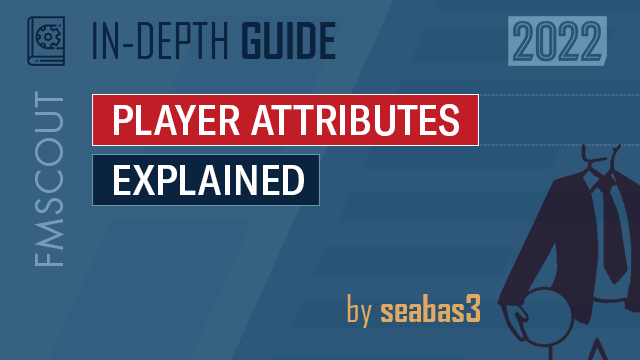-
UPDATED FOR FM22 -
- PART 2 OF THE
PLAYER GUIDE SERIES -
Generally, player attributes represent the abilities of a footballer and generally determine the performance of a player within matches. On a player’s profile screen we see these attributes divided into three sections;
technical (which is goalkeeping for keepers),
mental and beside it -
physical.
Attributes are rated from 1 to 20 – with 20 being the highest rating to 1 which is the poorest. On FMScout we have tools such as
Genie Scout and
FMSE which can not just accurately detail all attributes but with FMSE you can manipulate them. There is also the ability to do these things with FM’s In-Game Editor and
database editor.
Even though they may be whole numbers on the attributes screen, in training, development and other screens we see that the attributes system at least goes to 2 decimal places. For example; 18.55 rather than just a 18 – just a note to keep in the back of one’s mind that actually attributes are a lot more specific then one believes.
What exactly does each attribute mean though – and what effect does it have on a player’s performance? This is often misinterpreted in the community or misunderstood, just because a player has a 20 in finishing does not mean that this player will be the best finisher you have ever seen.
This seems confusing, counterintuitive but the reality is that for a player to be the best ever finisher; an array of attributes are needed. So what are these attributes for, what does a “20” in finishing actually represent?
Here we explain exactly what every attribute is and how to
properly interpret it.
Goalkeeping Attributes
Aerial Ability
How high a goalkeeper’s hands can reach when jumping.
This attribute refers to the height of a goalkeeper’s hands’ when jumping, the greater the rating the better the reach of the keeper when jumping. On a side note - jumping reach only relates to a Goalkeeper’s ability to head the ball.
Command of Area
How likely a goalkeeper is to attempt to claim aerial balls that are played into the box.
This is the likelihood that the keeper will attempt to claim the ball. It does not determine the successfulness of the claim as that is down to multitudes of attributes such as Aerial Ability, Handling, Anticipation, Decisions and Positioning.
Communication
How well a goalkeeper can communicate with defenders and organize the defense.
The greater the communication the more stability in your defense and less mistakes made as the goalkeeper will be constantly communicating. Keep in mind that this does not equate to a perfect defense, your other defenders need to be good as well to be rock solid. This is a good trait to aid young inexperienced players in defense.
Eccentricity
How likely a goalkeeper is to perform unexpected and risky actions.
A high rating does not equate to a good outcome on occasion. Unexpected and risky actions such as rushing out of the area to challenge attackers, dwelling on the ball for long periods, trying risky balls and dribbling out of the area. This only becomes a good attribute if you play a certain way which compliments such riskiness from the goalkeeper in build-up AND you have a keeper who is very good including other defenders.
Handling
How well a goalkeeper can hold on to the ball when attempting to catch it.
Better handling equals a higher chance of the ball being held rather than being spilled or parried. This works well with a brave goalkeeper who has a high Command of Area and in wet, snowy, or windy conditions.
Kicking
How far a goalkeeper can kick the ball.
The accuracy of a goalkeeper’s kick is not reflected in the Kicking attribute, rather it is found in Technique and Passing (which is a hidden attribute for goalkeepers). Other attributes dictate other aspects of a goalkeeper’s kick, the specific kicking attribute simply determines distance.
One-on-Ones
How well a goalkeeper can deal with one-on-one situations against opposition attackers.
This is not a stat which directly leads to a percentage of stopping a one-on-one opportunity. The best of goalkeepers can still falter, or attackers can be too clever, but the higher this attribute the better equipped the goalkeeper will most likely be in dealing (not stopping) with a one-on-one.
Reflexes
How well a goalkeeper can react to shots.
This is not just a short-distance factor but a reaction on all sorts of shots. The better reflexes the better the reaction but that does not necessarily mean they are best suited or in the best position to deal with certain shots.
Rushing Out
How well a goalkeeper can decide whether to run forward to try to claim loose balls and opposition passes close to his/her penalty area.
This is a decision and mental attribute, the actual speed to move out is not affected by this attribute but rather physical attributes such as Acceleration and Pace. The decision to rush out is also affected by other attributes which will affect the decision-making process on whether to rush out or not; these tend to be Anticipation, Composure, Concentration and Decisions.
Tendency to Punch
How likely a goalkeeper is to choose to punch when dealing with an aerial ball that is potentially catchable.
Other attributes affect how well a decision is made whether to punch or catch. A higher tendency to punch can cause a keeper to put more pressure on your defense by not catching the ball. This can be useful though if your keeper has poor catching ability, a high punch rating can allow the keeper to deal with the majority of situations comfortably by punching the ball.
Throwing
How accurately a goalkeeper can throw the ball to teammates.
This attribute defines the accuracy of your keeper throwing a ball, not the distance. For distance, the Strength attribute is needed to be high.
Technical Attributes
Corners
How accurately a player can deliver a corner kick to his intended target area.
This attribute displays that accuracy a player has in delivering a corner kick.
Crossing
How accurately a player can cross the ball from wide into the opposition penalty area to his intended target.
Just because there is accuracy in delivering a cross does not necessarily mean the crossing will be lethal. Having the opportunity to even create a cross or whipping it in with pace or on the move is not dictated by this crossing attribute. While this attribute does help, if it does not apply to your play or your player does not have other attributes to back up the ability to cross appropriately – it can be misleading.
Dibbling
How well a player can control the ball while running with it.
Self-explanatory, however a high dribbling attribute does not mean that your player is invincible. They can still lose the ball or dribble rather than pass when they should be passing. That all depends on traits, personality, and other attributes, but a higher rating means they are able to progress well with the ball.
Finishing
How accurately a player can shoot at his intended target area of the goal.
Another attribute which is regularly mis-interpreted. Finishing is about accuracy on the player’s intended target in the area of the goal. It does not mean they will finish with power or make the correct decision in shooting at a specific area of the goal. Finishing means how good the player is at shooting at an intended target area of the goal.
Free Kick Tacking
How accurately a player can deliver a free kick either indirectly to their intended target area or directly into their intended target area of the goal.
The player can deliver the ball to their intended target, but it does not mean that the free kick will be “deadly” or “bother the goalkeeper”. Other attributes indicate how fast, how much curve, the power and the type of free kick that is taken. This attribute simply states the accuracy of that player’s free kicks.
Heading
How accurately a player can head the ball to his intended target area.
Similar to finishing – this attribute only indicates the accuracy, not the jumping ability or the power of a header towards the intended target.
Long Shots
How accurately a player can shoot at his intended target area of the goal from outside the opposition penalty area.
Just because a player can shoot in on target from distance does not mean it will bother the keeper as much as the player or you would like. The power of the shot is determined by other attributes, but it works hand-in-hand with making sure it’s on target.
Long Throws
How far a player can throw the ball at throw-ins and how accurately he can deliver a long throw to his/her intended target area.
This attribute gives indication of not just accuracy but distance. However, it needs to be backed up by several other attributes – a player may have indicated targets but might not react quickly enough. Or they could have the ability to throw far and accurately but cannot read the runs and positions of fellow teammates.
Marking
How well a player can take up a position close to an opposition player that makes him a less viable passing option.
An excellent defensive attribute which works well in almost all scenarios. It is important however for a player to have physical stats to keep up with the ability to mark a player. They may get to the opposition in time or read the play well enough to close out an opposition passing option, but can they handle the break-away or read opposition runs and keep up with them? Other attributes do have an influence on marking.
Passing
How accurately a player can pass the ball to their intended target.
This is one of the most common attributes which is targeted by the community to be adjusted in future editions – but that is because it is mis-interpreted. Passing attribute is based on accuracy not pace, lethality, distance or reading the play to make a pass. Other attributes indicate the type of pass there is and the ability of the player to make unique passes – the passing attribute indicates the ability to get the ball from A to B.
Penalty Taking
How accurately a player can take a penalty kick.
Sometimes the best penalty takers do not have a 20-attribute rating within this attribute. Though it does help and indicate the accuracy of penalty takers and consistency – finishing and other attributes aid the ability of taking a penalty.
Tackling
How well a player can take the ball from an opposition player without committing a foul.
Another stat which indicates the ability of a player to tackle. The issue is can they read the play or keep up with a player to make the tackle in the first place.
Technique
How well a player can perform more challenging technical actions when he is on the ball.
Technique is a key attribute which is vastly underrated and ignored. “Technical actions” include challenging tasks on the football pitch such as long shots, volleys, long passes, curling the ball, playing with flair, doing tricks, or controlling difficult balls. This trait goes along with the majority of attributes and should be highlighted when signing or developing a player.
Mental Attributes
Aggression
How likely a player is to choose to get involved in a physical situation and how much he exerts physical force in such situations.
This does not indicate violent or unsporting behavior – that is indicated by hidden attributes. Aggression involves the amount of physicality in a physical situation, this includes attempting tackles, competing with opposition players for balls, marking or taking on players. Aggression can however get players into trouble as more physical play does involve more fouls and therefore a higher chance of getting sent off. It can be countered with other abilities such as Tackling, Anticipation, Concentration and Decisions so that a player does not foul, injure or get injured often.
Anticipation
How well a player can predict the movements and other actions of his teammates and opposition players.
A higher anticipation rating allows a player to react more quickly to events whether on or off the ball. A key thing to remember is that when the player is off the ball, their positioning will affect how well they react.
Bravery
How willing a player is to choose to perform an action that risks pain or injury.
This can be a positive and negative attribute. Low bravery will make the player avoid performing - in their opinion - an action which could cause harm to themselves, however that could lead to a lack of physical contact or appropriate defending or running onto a long ball. A high bravery stat would do the opposite – but greatly increase the possibility of injury, fouling and risk-taking.
Composure
How unaffected a player is by mental pressure when making a decision or performing their chosen action.
Pressure can come from all forms and avenues on and off the pitch. When in a scenario in which there is pressure, such as a decisive penalty kick or players closing down quickly in a scoring opportunity – a higher composure attribute reduces the negative effect of the player making a poorer decision or performing the action with less accuracy.
Concentration
How unaffected a player is by NOT losing focus when making a decision.
A player can lose focus during the match – the more their focus falls, the more likely there is to be a poorer decision or mistake made. A higher concentration rating reduces the rate and tenancy of which a player’s focus falls. Keep in mind however that players are human – even in FM.
Decisions
How well a player can evaluate the options he is aware of and choose which action to perform, when to perform it and how to perform it.
A player’s ability to make an effective decision is not just based on this stat – it is affected by other attributes such as Vision and Anticipation. Also, just because a player can read or make the correct decisions in their mind, they might not have the technique or the ability within the appropriate pace and time frame to execute those decisions correctly. A player may choose the right player to pass to for example, but be too slow or not have the passing accuracy to complete that pass.
Determination
How much a player tries to succeed in his actions during a match even in mentally exhausting circumstances.
“Mentally exhausting circumstances” sounds like a very unique situation – but rather it is quite common in football. When someone is performing badly, the team is losing, in pressure games or situations, trying to preserve a lead and so on. The higher the determination means the less likely a player is to give up or fall off in a match – it does not equate to success or turning things around in your favor. A player may have the greatest will power, but they may not have the attributes or enough influence on the rest of the team to really change the match or see through a tough situation.
Flair
How well a player takes opportunities to attempt unexpected actions when he/she is on the ball.
The higher the flair, the more often a player is to make an unexpected action – therefore making it harder for the opposition to handle and defend against. The issue becomes if that is all they do or they try tricks too often, which is directly related to Player Traits. Flair is a good option going forward, but players need the technique and ability to pull it off.
Leadership
How inspirational and motivational a player is to his/her teammates.
As a manager, this is the most important trait when considering a captain and vice-captain. On the pitch, having multiple leaders can motivate the rest of the squad to perform on any given match day or try their best even when things are going wrong. The only issue which may arise is if the leadership attribute conflicts with hidden attributes such as Controversy or you have multiple leaders and there is a conflict between these players. That can destroy a dressing room if not managed successfully.
Off the Ball
How well a player moves and positions himself, to either provide a passing option or create space for teammates to exploit, when he/she is off the ball and his/her team is in possession.
This is the attacking equivalent of Positioning which is mainly for defensive roles or plays. They are able to make wise runs or move into certain positions on the pitch to open up play going forward or receiving a pass to lead to a better opportunity. Keep in mind that this trait can only be capitalised on if your tactic is applicable to it – if you restrain your players too much then that could conflict with the attribute. Though that is not always the case, as even in structured and rigid systems off the ball movement is key for following your tactic to the letter.
Positioning
How well a player moves and positions himself, in order to deal with an opposition attack, where he/she is off the ball and the opposition team is in possession.
The defensive side of Off the Ball. This trait does not just apply to defenders but midfielders and even forwards. Being in the correct position to either man-mark players, cut off passing lanes, fill in spaces in-between lines or even be in a position to start a counterattack – all of that is influenced by the Positioning attribute. Of course, other attributes affect positioning such as physicals, vision, and anticipation – but overall, this is an important attribute to focus on.
Teamwork
How closely a player follows his tactical instructions and how aware he is of the positions and movements of his teammates.
A higher rating means that the player will play better as a unit with the team. Which may seem like a positive thing; however, this could mean passing the ball in a situation where shooting it or taking on a player when they have the capabilities to do so is the better solution. Likewise, a lower rating indicates a more selfish decision such as shooting at goal instead of passing – however this may be positive for a super clinical striker who can create goals out of nothing.
Vision
How well a player observes the options available to him when he/she is on the ball.
This means that a player is more likely to be aware of more options and can potentially make more effective decisions in play. This does not mean a player is going to make the correct decision all the time as that is affected by other attributes such as Decisions. Also, Player Traits may indicate that the player dwells on the ball too long – or other attributes could indicate that the player can see the field well but cannot make the appropriate actions due to a lack of attributes.
Work Rate
How much physical effort a player puts into his actions during a match.
Another trait which can be both positive and negative. Depending on multiple inputs such as tactics, training, physical attributes, and age – this attribute can either be effective or completely useless. A high work rate may be appropriate – but a player may not be able to last the full 90 minutes due to poor physicals. High work rate players can also suit certain tactical systems such as Gegenpressing so well that it could make your tactic and team perform at incredible levels.
Physical Attributes
Acceleration
How quickly a player can reach his maximum speed when running.
This attribute is about the ability of a player to get to their maximum speed when running – this does not mean that they are extremely fast as that is dependent upon pace. This is of great use for those scenarios where a player needs that “burst of pace” to quickly get away or run into a free area.
Agility
How well a player can start, stop, and move in a new direction.
This attribute is the ability of the player to move on and off the ball. On the ball, other attributes such as dribbling, flair, etc. apply to the ability to keep the ball while moving in such a way.
Balance
How well a player can stay steady on his feet when he is under physical pressure.
This is an important attribute to have in all areas of the pitch. Physical pressure comes from the opposition trying to get the ball or taking the ball away from a player whether moving or stationary.
Jumping Reach
How high a player’s head can reach when jumping.
Taller players have an advantage because their height gives them an advantage. This attribute is basically one’s vertical ability when jumping. Whether he needs to jump or put in a specific amount of effort is down to other attributes such as height, traits, and other attributes.
Natural Fitness
How well a player can retain condition when injured or not training, recover condition between matches, gain match fitness when playing matches and avoid jadedness caused by matches and training. Also, how well a player is able to retain his physical attribute ratings as he ages.
Essentially, a player with higher Natural Fitness can be more capable of spending more time playing matches and being available for matches. Multiple attributes influence this over time such as Stamina and hidden attributes such as Jadedness and Injury Proneness.
Pace
How fast a player can run when he has reached his maximum speed.
Simply the top speed of a player. How long it takes to get to that maximum speed is based on the acceleration of a player. Keep in mind a player is able to run faster without the ball than with it.
Stamina
How well a player can retain condition while exerting effort during a match.
Higher stamina reduces the effect of a player’s conditioning falling when they put in effort or perform any action during a match.
Strength
How well a player is able to exert physical force on an opposition player.
Strength is an attribute which indicates how likely a player can succeed in a situation which involves some form of physicality in the game – such as shielding, tackling, and competing for balls. Strength does not indicate the potential to foul someone, however if other attributes are poor or the player’s personality is destructive – they may misuse their strength.
Hidden Attributes
Adaptability
How well a player settles in a new country.
Are players able to handle new scenarios, countries, languages, and lifestyle’s? The higher the rating the better they are able to settle in a new country. Mentions of adaptability can be seen in scout reports or even looking at form through a player’s history if they have travelled or moved several times.
Consistency
How likely a player is to perform to his full ability in any particular match.
This strictly affects technical and mental attributes of a player – however the level of those attributes indicates how good a player is. Just because someone is consistent, does not indicate that they are world class or have the ability to change a game.
Dirtiness
How likely a player is to try and break the rules to gain an advantage.
Essentially the higher the rating the more of a “shit-house” the player is – which means more fouls or unethical play. When you receive scout reports; usually it is defined as the player having a Competitive Streak – you can also find details with someone’s fouls, yellow and red cards recorded throughout their history. Keep in mind that just because someone has a lot of cards or fouls does not necessarily mean they are dirty; it could be down to tactics and style of play.
Important Matches
How well a player performs in big, high pressure games.
Will players choke when it matters or perform well? This does not come down to consistency but rather on the day of a big game how well can a player handle the pressure. Again, players are humans and will make mistakes and just because someone performs well in a final – does not mean that they will consistently be a good player.
Injury Proneness
How likely a player is to suffer an injury during a match or in training.
There are other factors which affect the rate at which a player gets injured such as training intensity, tactics, and certain attributes. This attribute indicates how prone a player is likely to get injured – you can see potentially if a player is injured or not by looking at their Injuries in history and scout reports. Just because a player has a bad injury does not mean they are injury prone… HOWEVER it can indicate that they may become more susceptible to injuries in the future, especially if they do not recover appropriately or have appropriate staff and facilities surrounding them to recover.
Versatility
How well a player plays in a position for which he lacks familiarity.
This is a great hidden attribute to have for training players into unfamiliar positions. You are able to find how well they perform in each position in the general overview of a player and a note can be made in scout reports. If studying opposition or scouting players, keeping an eye on where they play, and their roles can show that they may or may not be versatile.
--
Here we have divided up every attribute, defining every single one accurately according to Sports Interactive’s own definitions. But I can already hear questions forming in your mind, what about shot power? How do we really know how
successful a player can be in a tackle? Why can’t things be clear like in FIFA where there is a given number for everything, are there hidden numbers or attributes which define a success rate?
We have all asked these questions but the truth is that there is no secret formula. In order to truly understand how great a player is, a
combination of attributes are what leads to actions taking place and indicate how good a player’s ability is. So next on your list is to head over to the Utilizing Player Attributes Guide - there it is explained what combination of attributes indicate not just the
ability of a player but
how well a player can perform that action.
But before you go - keep in mind, this is not FIFA. You are out of control of your players on the football pitch and they are human and will make mistakes.






![FM26 Data Tweaks [v1.1 | v1.8]](assets/downloads/fm26/fm26-data-tweaks-by-sirtavares-v2.th.png)


![TinyHips' Dark Mode Skin v5.3 [Win + MacOS] *UPDATED 26.1.1 HOTFIX*](assets/downloads/fm26/fm26-dark-mode-skin.th.png)

Discussion: Player Attributes Explained - FM 2022 Guide
No comments have been posted yet..